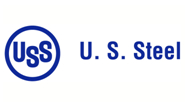Steel Mills

U.S. Steel Bullish on 2022 After Strong Start to the Year
Written by Tim Triplett
March 18, 2022
U.S. Steel Corp. expects to see record EBITDA for the first quarter totaling approximately $1.3 billion, a new all-time high for the period. In guidance issued Thursday, the steelmaker forecast adjusted diluted earnings per share in the range of $2.96 to $3.00.
“We expect to deliver another strong quarter of safety, adjusted EBITDA, free cash flow, and operational performance,” U.S. Steel President and CEO David Burritt said. “At the beginning of the year, we expected market softness for the first quarter, along with the normal seasonal impacts related to our mining operations. We are exiting the first quarter with spot business accelerating, steel prices rising, and the longest backlog at our Big River Steel operations since October.”
![]() Burritt said the company is realizing significant upside in its fixed-price contracts and expects to see improving market conditions in the second quarter as seasonal demand picks up and as buyers seek a more reliable, regional steel supply given rising geopolitical risks and cost volatility.
Burritt said the company is realizing significant upside in its fixed-price contracts and expects to see improving market conditions in the second quarter as seasonal demand picks up and as buyers seek a more reliable, regional steel supply given rising geopolitical risks and cost volatility.
U.S. Steel has been monitoring the situation in Ukraine and has taken steps to render aid, he said. The company’s workforce in Slovakia is safe and has supplied over 7,840 meals for refugees, working with Ukrainian suppliers to send 17 tons of food to Ukraine, and providing 800 beds for refugees arriving in Kosice, among other donations to UNICEF and the Red Cross.
Earnings in U.S. Steel’s flat-rolled segment are expected to take a $150 million hit in the quarter due to normal seasonal headwinds in mining operations, rising raw materials costs and cautious spot market activity, partially offset by increase revenue from fixed-price contracts, the company said.
The company expects its minimill segment to deliver first-quarter margins similar to 2021 levels. “The recent geopolitical events are increasing spot steel demand, particularly at our Big River Steel operations, resulting in a growing backlog of orders,” Burritt said in a statement. “Considering the conflict in Ukraine and its impact on the global metallics supply, our raw material inventories remain well-positioned to continue meeting customer demand, and contingency plans are in place to ensure raw materials are available from alternate sources.”
Steel prices and demand were stable throughout January and February, and the company’s European segment benefited from getting its third blast furnace back online after a 60-day planned outage. Adjusted EBITDA from European operations are expected to approach the strong fourth-quarter levels.
“Demand remains healthy from our facility in Slovakia in March, in light of the conflict in Ukraine, and our risk mitigation plans are working as we currently have inventory on site or in-transit to continue meeting customer demand,” the company stated. “Alternate sources of supply are underway to continue meeting demand as we closely monitor the rapidly changing geopolitical situation.”
First-quarter adjusted earnings for the steelmaker’s tubular segment are expected to nearly double the prior quarter’s performance as selling prices continue to accelerate, and the company said it is well positioned to serve the growing U.S. energy market.
Looking ahead, Burritt said U.S. steel remains bullish on its prospects for 2022. “We are actively monitoring the conflict in Ukraine for impacts and risks to our people and business. Today’s market dynamics reinforce what makes U.S. Steel’s business model unique. Our low-cost, captive iron ore assets in Minnesota are a sustainable competitive advantage that cannot be replicated by the competition. We are increasingly translating this competitive advantage to our growing fleet of electric arc furnaces. We are building a pig iron machine at Gary Works to supply Big River Steel with up to 50% of its ore-based metallics needs by the first half of 2023 and will continue to identify additional opportunities to broaden our metallics strategy. These actions build upon the regionally-sourced, low-cost iron ore advantage our U.S. blast furnaces have and the strategy in place with Big River Steel to supplement a portion of their prime scrap needs with home scrap from our integrated operations.”
By Tim Triplett, Tim@SteelMarketUpdate.com

Tim Triplett
Read more from Tim TriplettLatest in Steel Mills

Millett sees tariffs, CORE case benefiting SDI
Steel Dynamics' top exec thinks Trump’s tariff policies, as well as the results from the recent CORE case, will prove advantageous to the Fort Wayne, Ind.-based steelmaker and aluminum company.

USW digs in on opposition to USS-Nippon deal
“We remain deeply concerned about the national and economic security implications of the subject transaction,” the union stated in the letter dated April 21.

SDI’s Q1 earnings slump on-year, but up sequentially
SDI earnings slip in first quarter year over year, but are up sequentially.

POSCO inks MoU with Hyundai on Louisiana EAF mill
POSCO has signed a Memorandum of Understanding (MoU) with Hyundai Motor Group that includes an equity investment in Hyundai’s previously announced EAF mill set to be built in Louisiana.

CRU: Tata Steel looks to shed 1,600 jobs in the Netherlands
The company said, “The challenging demand conditions in Europe driven by geopolitical developments, trade and supply chain disruptions and escalating energy costs have affected the operating costs and financial performance."
